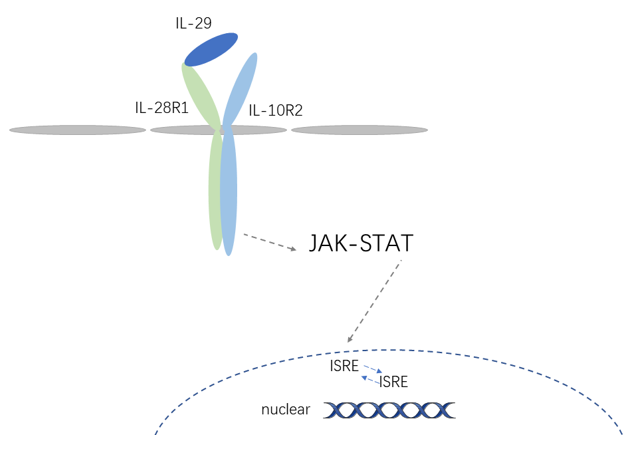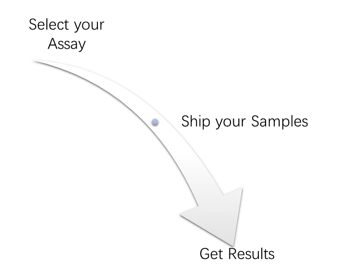Introduction
IL-29 is a member of the interferon family. It is mainly derived from Th17 cells, Th1 cells, and keratinocytes infiltrated into the skin, of which Th17 cells are the most important source. It is expressed at low levels in a variety of human organs, including blood, brain, lung, ovary, pancreas, pituitary, prostate, and testes. Almost all nucleated cells can express IL-29 when they are infected by certain viruses or stimulated by bacterial components. IL-29 has similar biological activities and functions as type I IFN in terms of anti-virus, anti-proliferation, anti-tumor, and immune regulation.
Mechanism and Function
IL-29 and IL-28 share a heterodimeric receptor complex composed of type II cytokine receptor family members IL-28R1 and IL-10R2, where IL-28R1 is the binding subunit and IL-10R2 is the auxiliary subunit. IL-28R1 is expressed at a high level in human gastrointestinal, respiratory system, heart and some glandular cells of the human body. IL-28R1 expression is relatively low in the brain, while IL-10R2 is commonly expressed in hematopoietic and non-hematopoietic stem cells. Like type I IFN, it activates the Jak- signal transducer and activator of transcription (STAT) signal transduction pathway. IL-29 first forms the IL28R1-IL29-IL10R2 ternary complex with its specific receptor complex, which is transduced by two receptor chains located in the cell. The signal is induced, and then the signal cascade is initiated. After a multi-step phosphorylation reaction, STAT2 is activated, leading to interferon-activated gene factor 3 complex (ISRE) interaction, thereby regulating gene transcription.
The main functions of IL-29 are anti-virus, anti-cell proliferation and immune regulation. The antiviral activity of IL-29 is mainly to induce host cells to express a variety of antiviral factors, including 2',5'-Ologoadenylate synthetase (OAS), MxA protein, double-stranded RNA dependent protein kinase, PKR, etc. This can reduce virus replication or cause the virus to produce cytopathic effects. IL-29 mainly exerts its anti-proliferative activity by inducing cell apoptosis, it can also inhibit tumor angiogenesis by inhibiting endothelial cell activity, and indirectly kill tumors by enhancing the immune activity of T cells, NK cells, DC cells and macrophages cell. Since IL-29 can activate the Jak-STAT signaling pathway, IL-29 has an effect on monocytes and T cells. When the concentration of IL-29 is high, it can induce IL-8, IL-6, IL-10 and other cytokines in peripheral blood mononuclear immune cells. IL-29 can also directly act on CD4+ T cells, inhibiting their Th2 differentiation and GATA3 expression, thereby inhibiting the Th2 response of initial CD4+ T cells and memory T cells.
 Fig 1. Mechanism of Signaling
Fig 1. Mechanism of Signaling
Creative Proteomics can provide cytokine detection platform for scientific research. According to different purposes, our dedicated analysts will customize exclusive solutions for you. We aim to provide customers with high-quality and convenient services to help you accelerate the progress of your project.
Our cytokine detection service includes but is not limited to:
- Quantitative and qualitative detection of cytokines in different species
- Quantitative and qualitative detection of cytokine antibodies
- Quantitative and qualitative detection of single/multiple cytokines
Sample requirements
- Sample Types-Blood, serum, plasma, cerebrospinal fluid, cell culture supernatant, tissue homogenate, cell culture medium, urine, tumor, etc.
- Sample Volume-It is optimal for at least 200µl of each sample. This volume allows for triplicate testing of each sample.
Our advantages:
- Efficient design: Multiplex reaction detecting in various methods are available, which can be selected according to different samples and requirements.
- Sensitive detection: High-quality antibodies are used in the detection process to improve detection specificity and accuracy.
- Reliable results: The feedback results are professional and efficient.
Technology platform:
We mainly provide the Luminex cytokine detection platform. Luminex uses fluorescently encoded microspheres with specific antibodies to different target molecules. The different microspheres can be combined freely to a certain extent so that up to 100 analytes can be tested multiple times simultaneously in a single experiment.
The Luminex cytokine assay platform has the following advantages:
- Multiple detection: simultaneous detection of 100 biological targets
- Short experiment time: 1-3 weeks
- High sensitivity: the lower limit of accurate quantification is as low as 0.1 pg/mL
- Save samples: only need a sample volume as low as 25 μL
- Time saving: the experiment process only takes 4 hours
For your different needs, we can also provide the following detection methods:
- Enzyme-linked immunosorbent assay (ELISA)
- Flow cytometry
Workflow

For more information about the IL-29 detection service or need other detection requirements, please contact us.
References:
- Sheppard P, Kindsvogel W, Xu W, et al. IL-28, IL-29 and their class II cytokine receptor IL-28R. Nature Immunology, 2003, 4(1):63-68.
- Lin T Y, Chiu C J, Kuan C H, et al. IL-29 promoted obesity-induced inflammation and insulin resistance. Cellular & molecular immunology, 2019, 17(4).



